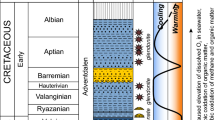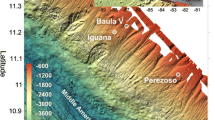Abstract
Several hundred hydrothermal vent complexes were formed in the Vøring Basin as a consequence of magmatic sill emplacement in the late Palaeocene. The 6607/12-1 exploration well was drilled through a 220-m-thick sequence of Eocene–Miocene diatomites with carbonate nodules above the apex of one of these vent complexes. Analysed calcites and dolomites from this interval have isotopic signatures typical for methane seep carbonates, with low δ13C signatures of −28 to −54‰ PDB. The data suggest that the vent complex acted as a fluid migration pathway for about 50×106 years after its formation, leading to near-surface microbial activity and seep carbonate formation.







Similar content being viewed by others
References
Adshead JD (1996) Stable isotopes, 14C dating, and geochemical characteristics of carbonate nodules and sediment from an active vent field, northern Juan de Fuca Ridge, northeast Pacific. Chem Geol 129:133–152
Aharon P (1994) Geology and biology of modern and ancient submarine hydrocarbon seeps and vents: an introduction. Geo-Mar Lett 14:69–73
Aiello IW, Garrison RE, Moore JC, Kastner M, Stakes D (2001) Anatomy and origin of carbonate structures in a Miocene cold-seep field. Geology 29:1111–1114
Aloisi G, Pierre C, Rouchy J-M, Foucher J-P, Woodside J, MEDINAUT Scientific Party (2000) Methane-related authigenic carbonates of eastern Mediterranean Sea mud volcanoes and their possible relation to gas hydrate destabilization. Earth Planet Sci Lett 184:321–338
Blunck TD, Blanchet H (1986) 6607/12-1 final report. Elf Aquitane Norge a/s
Blystad P, Brekke H, Færseth RB, Larsen B, Skogseid J, Tørudbakken B (1995) Structural elements of the Norwegian continental shelf. Part II. The Norwegian Sea region. The Norwegian Petroleum Directorate, NPD Bull no 8
Boetius A, Ravenschlag K, Scubert CJ, Rickert D, Widdel F, Gieseke A, Amman R, Jørgensen BB, Witte U, Pfannkuche O (2000) A marine microbial consortium apparently mediating anaerobic oxidation of methane. Nature 407:623–626
Bohrmann G, Greinert J, Suess E, Torres M (1998) Authigenic carbonates from the Cascadia subduction zone and their relation to gas hydrate stability. Geology 26:647–650
Brooks JM, Kennicutt MC, Fay RR, McDonald TJ (1984) Thermogenic gas hydrates in the Gulf of Mexico. Science 225:409–411
Campbell KA, Farmer JD, Des Marais D (2002) Ancient hydrocarbon seeps from the Mesozioc convergent margin of California: carbonate geochemistry, fluids and palaeoenvironments. Geofluids 2:63–94
Cita MB, Woodside JM, Ivanov MK, Kidd RB, Limonov AF, Scientific Party Cruise TTR3—Leg 2 (1995) Fluid venting from a mud volcano in the Mediterranean Ridge Diapiric Belt. Terra Nova 7:453–458
Deyhle A, Kopf A (2001) Deep fluids and ancient pore waters at the backstop: stable isotope systematics (B, C, O) of mud-volcano deposits on the Mediterranean Ridge accretionary wedge. Geology 29:1031–1034
Dia AN, Castrec-Rouelle M, Boulègue J, Comeau P (1999) Trinidad mud volcanoes: where do the expelled fluids come from? Geochim Cosmochim Acta 63:1023–1038
Elvert M, Greinert J, Suess E (2001) Carbon isotopes of biomarkers derived from methane-oxidizing microbes at Hydrate Ridge, Cascadia convergent margin. Geophys Monogr 124:115–129
Epstein S, Buchsbaum R, Lowenstam H, Urey HC (1953) Revised carbonate-water isotopic temperature scale. Geol Soc Am Bull 64:1315–1326
Gaillard C, Rio M, Rolin Y, Roux M (1992) Fossil chemosynthetic communities related to vents or seeps in sedimentary basins: the pseudobioherms of Southwestern France compared to other world examples. Soc Econ Paleontol Mineral 7:451–465
Greinert J, Bohrmann G, Suess E (2001) Gas hydrate-associated carbonates and methane-venting at Hydrate Ridge: classification, distribution, and origin of authigenic lithologies. In: Natural gas hydrates: occurrence, distribution, and detection. Geophys Monogr 124:99–113
Hein JR, O’Neil JR, Jones MG (1979) Origin of authigenic carbonates in sediment from the deep Bering Sea. Sedimentology 26:681–705
Heinrich R (1989) Diagenetic environments of authigenic carbonates and opal-CT crystallization in lower Miocene to upper Oligocene deposits of the Norwegian Sea (ODP Site 643, Leg 104). In: Eldholm O, Thiede J, Taylor E (eds) Proc Ocean Drilling Program, Sci Results 104:233–247
Hesse R, Harrison WE (1981) Gas hydrates (clathrates) causing pore-water freshening and oxygen isotope fractionation in deep-water sedimentary sections of terrigenous continental margins. Earth Planet Sci Lett 55:453–462
Higgins GE, Saunders JB (1974) Mud volcanoes—their nature and origin. Verhandl Naturf Ges Basel 84:101–152
Higgins IJ, Quale JR (1970) Oxygenation of methane by methane-grown Pseudomonas methanica and Methanomonas methanooxidans. Biochem J 118:201–208
Hinrichs K-U, Hayes JM, Sylva SP, Brewer PG, DeLong EF (1999) Methane-consuming archaebacteria in marine sediments. Nature 398:802–805
Hovland M, Judd A (1988) Seabed pockmarks and seepages: impact on geology, biology and the marine environment. Graham and Trotman, London
Hovland M, Talbot MR, Qvale H, Olaussen S, Aasberg L (1987) Methane-related carbonate cements in pockmarks of the North Sea. J Sediment Petrol 57:881–892
Irwin H, Curtis C, Coleman M (1977) Isotopic evidence for source of diagenetic carbonates formed during burial of organic-rich sediments. Nature 269:209–213
Jakubov AA, Ali-Zade AA, Zeinalov MM (1971) Grayazeve vulkany Azerbaidzhanskoi SSR: Atlas (Mud volcanoes of the Azerbaijan SSR). Azerbaijan Acad Sci, Baku
Jamveit B, Svensen H, Podladchikov JJ, Planke S (2003) Hydrothermal vent complexes associated with sill intrusions in sedimentary basins. Geol Soc Lond Spec Publ (in press)
Kohn MJ, Riciputi LR, Stakes D, Orange DL (1998) Sulfur isotope variability in biogenic pyrite: reflections of heterogeneous bacterial colonization? Am Mineral 83:1454–1468
Kopf A, Behrmann JH (2000). Extrusion dynamics of mud volcanoes on the Mediterranean Ridge accretionary complex. Geol Soc Spec Publ 174:169–204
Le Pichon X, Foucher J-P, Boulègue J, Henry P, Lallemant S, Benedetti M, Avedik F, Mariotti A (1990) Mud volcano field seaward of the Barbados Accretionary Complex: a submersible survey. J Geophys Res 95(B6):8931–8943
Martin JB, Kastner M, Henry P, Le Pichon X, Lallement S (1996) Chemical and isotopic evidence of sources of fluids in a mud volcano field seaward of the Barbados accretionary wedge. J Geophys Res 101:20325–20345
Milkov AV (2000) Worldwide distribution of submarine mud volcanoes and associated gas hydrates. Mar Geol 167:29–42
Mørk MBE, Leith DA, Fanavoll S (2001) Origin of carbonate-cemented beds on the Naglfar Dome, Vøring Basin, Norwegian Sea. Mar Petrol Geol 18:223–234
Paull CK, Chanton JP, Neumann AC, Coston JA, Martens CS (1992) Indicators of methane-derived carbonates and chemosynthetic organic carbon deposits: examples from the Florida escarpment. Palaios 7:361–375
Peckmann J, Reimer A, Luth U, Hansen BT, Heinicke C, Hoefs J, Reitner J (2001) Methane-derived carbonates and authigenic pyrite from the northwestern Black Sea. Mar Geol 177:129–150
Raisewell R (1987) Non-steady state microbiological diagenesis and the origin of concretions and nodular limestones. In: Marshall JD (ed) The diagenesis of sedimentary sequences. Geol Soc Spec Publ 36:41–54
Reeburg WS (1980) Anaerobic methane oxidation: rate depth distribution in Skan Bay sediments. Earth Planet Sci Lett 47:345–352
Ritger S, Carson B, Suess E (1987) Methane-derived authigenic carbonates formed by subduction-induced pore-water expulsion along the Oregon/Washington margin. Geol Soc Am Bull 98:147–156
Roberts HH, Aharon P (1994) Hydrocarbon-derived carbonate buildups of the northern Gulf of Mexico continental slope: a review of submersible investigations. Geo-Mar Lett 14:135–148
Robertson A, Ocean Drilling program Leg 160 Scientific Party (1996) Mud volcanism on the Mediterranean Ridge: initial results of Ocean Drilling Program Leg 160. Geology 24:239–242
Simoneit BRT, Kawka OE, Brault M (1988) Origin of gases and condensates in the Guaymas Basin hydrothermal system (Gulf of California). Chem Geol 71:169–182
Stakes DS, Orange D, Paduan JB, Salamy KA, Mahler N (1999) Cold-seeps and authigenic carbonate formation in Monterey Bay, California. Mar Geol 159:93–109
Suess E, Whiticar MJ (1989) Methane-derived CO2 in pore fluids expelled from the Oregon subduction zone. Palaeogeogr Palaeoclimatol Palaeoecol 71:119–136
Ussler W, Paull CK (1995) Effects of ion exclusion and isotopic fractionation on pore water geochemistry during gas hydrate formation and decomposition. Geo-Mar Lett 15:37–44
Vinogradov AP, Galimov EM (1970) Carbon isotopes and the origin of petroleum. Geokhimiya 3:275–296
Whiticar MJ, Suess E, Wehner H (1985) Thermogenic hydrocarbons in surface sediments of the Bransfield Strait, Antarctic Peninsula. Nature 314:87–90
Acknowledgments
This study was supported by grant 120897 to Jamtveit/Svensen and by the FUNN program (analytical work) from the Norwegian Research Council. We would like to thank TGS-NOPEC for access to seismic data, and Debra Stakes and an anonymous reviewer for constructive comments. This work was motivated by a seismic profile appearing in an article by H. Carstens in GEO (September 2001), showing the position of the 6607/12-1 borehole and the eye structure (described as a buried mud volcano).
Author information
Authors and Affiliations
Corresponding author
Rights and permissions
About this article
Cite this article
Svensen, H., Planke, S., Jamtveit, B. et al. Seep carbonate formation controlled by hydrothermal vent complexes: a case study from the Vøring Basin, the Norwegian Sea. Geo-Mar Lett 23, 351–358 (2003). https://doi.org/10.1007/s00367-003-0141-2
Received:
Accepted:
Published:
Issue Date:
DOI: https://doi.org/10.1007/s00367-003-0141-2




